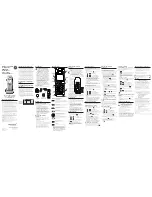
What is the most important information I should know about LANTUS?
•
Do not change the insulin you are using without talking to your healthcare provider.
Any
change of insulin should be made cautiously and only under medical supervision. Changes in
insulin strength, manufacturer, type (for example: Regular, NPH, analogs), species (beef, pork,
beef-pork, human) or method of manufacture (recombinant DNA versus animal source insulin) may
need a change in the dose. This dose change may be needed right away or later on during the
first several weeks or months on the new insulin. Doses of oral anti-diabetic medicines may also
need to change, if your insulin is changed.
•
You must test your blood sugar levels while using an insulin, such as LANTUS.
Your
healthcare provider will tell you how often you should test your blood sugar level, and what to do
if it is high or low.
•
Do NOT dilute or mix LANTUS with any other insulin or solution.
It will not work and you may
lose blood sugar control, which could be serious.
•
LANTUS
comes as U-100 insulin and contains 100 units of LANTUS per milliliter (mL). One
milliliter of U-100 insulin contains 100 units of insulin. (1 mL = 1 cc).
What is Diabetes?
•
Your body needs insulin to turn sugar (glucose) into energy. If your body does not make enough
insulin, you need to take more insulin so you will not have too much sugar in your blood.
•
Insulin injections are important in keeping your diabetes under control. But the way you live, your
diet, careful checking of your blood sugar levels, exercise, and planned physical activity, all work
with your insulin to help you control your diabetes.
What is LANTUS?
•
LANTUS (insulin glargine [recombinant DNA origin]) is a long-acting insulin. Because LANTUS is
made by recombinant DNA technology (rDNA) and is chemically different from the insulin made
by the human body, it is called an insulin analog. LANTUS is used to treat patients with diabetes
for the control of high blood sugar. It is used once a day to lower blood sugar.
•
LANTUS is a clear, colorless, sterile solution for injection under the skin (subcutaneously).
•
The active ingredient in LANTUS is insulin glargine. The concentration of insulin glargine is 100
units per milliliter (mL), or U-100. LANTUS also contains zinc, metacresol, glycerol, polysorbate
20 and water for injection as inactive ingredients. Hydrochloric acid and/or sodium hydroxide may
be added to adjust the pH.
•
You need a prescription to get LANTUS. Always be sure you receive the right insulin from the
pharmacy.
Who should NOT take LANTUS?
Do not take LANTUS if you are allergic to insulin glargine
or any of the inactive ingredients in
LANTUS. Check with your healthcare provider if you are not sure.
Before starting LANTUS, tell your healthcare provider about all your medical conditions
including if you:
•
have liver or kidney problems.
Your dose may need to be adjusted.
•
are pregnant or plan to become pregnant.
It is not known if LANTUS may harm your unborn
baby. It is very important to maintain control of your blood sugar levels during pregnancy. Your
healthcare provider will decide which insulin is best for you during your pregnancy.
•
are breast-feeding or plan to breast-feed.
It is not known whether LANTUS passes into your
milk. Many medicines, including insulin, pass into human milk, and could affect your baby. Talk
to your healthcare provider about the best way to feed your baby.
•
about all the medicines you take including
prescription and non-prescription medicines,
vitamins, and herbal supplements.
How should I use LANTUS?
See the
0
Instructions for Use
0
including the
0
How do I draw the insulin into the syringe?
0
section
for additional information.
•
Follow the instructions given by your healthcare provider about the type or types of insulin you
are using. Do not make any changes with your insulin unless you have talked to your healthcare
provider. Your insulin needs may change because of illness, stress, other medicines, or changes
in diet or activity level. Talk to your healthcare provider about how to adjust your insulin dose.
•
You may take LANTUS at any time during the day but you must take it at the same time every
day.
•
Only use LANTUS that is clear and colorless. If your LANTUS is cloudy or slightly colored, return
it to your pharmacy for a replacement.
•
Follow your healthcare provider’s instructions for testing your blood sugar.
•
Inject LANTUS under your skin (subcutaneously) in your upper arm, abdomen (stomach area), or
thigh (upper leg). Never inject it into a vein or muscle.
•
Change (rotate) injection sites within the same body area.
What kind of syringe should I use?
•
Always use a syringe that is marked for U-100 insulin. If you use other than U-100 insulin syringe,
you may get the wrong dose of insulin causing serious problems for you, such as a blood sugar
level that is too low or too high. Always use a new needle and syringe each time you give LANTUS
injection.
•
NEEDLES AND SYRINGES MUST NOT BE SHARED.
•
Disposable syringes and needles should be used only once. Used syringe and needle should be
placed in sharps containers (such as red biohazard containers), hard plastic containers (such as
detergent bottles), or metal containers (such as an empty coffee can). Such containers should be
sealed and disposed of properly.
Mixing with LANTUS
•
Do NOT dilute or mix LANTUS with any other insulin or solution.
It will not work as intended
and you may lose blood sugar control, which could be serious.
Instructions for Use
How do I draw the insulin into the syringe?
•
The syringe must be new and does not contain any other medicine.
•
Do not mix LANTUS with any other type of insulin.
Follow these steps:
1. Wash your hands with soap and water or with alcohol.
2. Check the insulin to make sure it is clear and colorless. Do not use the insulin after the expiration
date stamped on the label, if it is colored or cloudy, or if you see particles in the solution.
3. If you are using a new vial, remove the protective cap.
Do not
remove the stopper.
4. Wipe the top of the vial with an alcohol swab. You do not have to shake the vial of LANTUS before
use.
5. Use a new needle and syringe every time you give an injection. Use disposable syringes and
needles only once. Throw them away properly.
Never
share needles and syringes.
6. Draw air into the syringe equal to your insulin dose. Put the needle through the rubber top of the
vial and push the plunger to inject the air into the vial.
7. Leave the syringe in the vial and turn both upside down. Hold the syringe and vial firmly in one
hand.
8. Make sure the tip of the needle is in the insulin. With your free hand, pull the plunger to withdraw
the correct dose into the syringe.
9. Before you take the needle out of the vial, check the syringe for air bubbles. If bubbles are in
the syringe, hold the syringe straight up and tap the side of the syringe until the bubbles float to
the top. Push the bubbles out with the plunger and draw insulin back in until you have the correct
dose.
10. Remove the needle from the vial. Do not let the needle touch anything. You are now ready to
inject.
How do I inject LANTUS?
Inject LANTUS under your skin. Take LANTUS as prescribed by your healthcare provider.
Follow these steps:
1. Decide on an injection area - either upper arm, thigh or abdomen. Injection sites within an injection
area must be different from one injection to the next.
2. Use alcohol or soap and water to clean the injection site. The injection site should be dry before
you inject.
3. Pinch the skin. Stick the needle in the way your healthcare provider showed you. Release the
skin.
4. Slowly push in the plunger of the syringe all the way, making sure you have injected all the insulin.
Leave the needle in the skin for about 10 seconds.
5. Pull the needle straight out and gently press on the spot where you injected yourself for several
seconds.
Do not rub the area.
6. Follow your healthcare providers instructions for throwing away the used needle and syringe. Do
not recap the used needle. Used needle and syringe should be placed in sharps containers (such
7
Lantus PI.April.2010






































